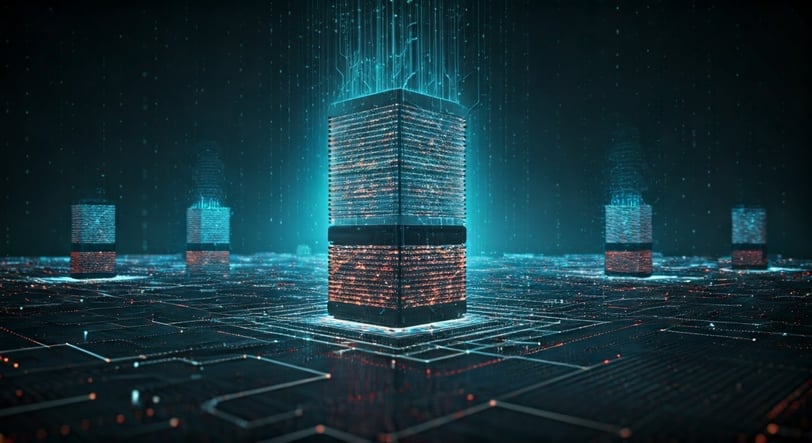
Edge Computing in 2025: Decentralizing Data for Enhanced Performance and Security
Edge computing is changing the way we handle data. It does this by processing data closer to where it comes from, not just in traditional data centers. This brings better data security and leads to faster decision-making. It also allows for new and varied use cases across different industries, as experts in the industry are pushing for more edge cloud computing solutions. This way, we can solve latency issues and keep strong operations, even when connectivity is weak. Businesses are using this technology for real-time applications. As a result, edge computing is becoming an essential part of global data management for 2025 and beyond.
ARTIFICIAL INTELLIGENCE (AI)
Key Highlights
Edge computing in 2025 will prioritise decentralised data processing, enhancing operational efficiency and response times through local data management.
Integration of cutting-edge technologies like AI models, 5G, and micro AI will redefine applications across healthcare, retail, transportation, and manufacturing industries.
Enhanced edge-to-cloud collaborations will streamline operations while leveraging cloud platforms for scalability and strategic partnerships.
Security measures emphasising decentralised systems will fortify data privacy and protection against threats at edge nodes.
Industries will witness real-time breakthroughs, such as autonomous vehicles and predictive patient healthcare systems, transforming their operational frameworks for the future.
Introduction
Edge computing is changing the way we handle data. It does this by processing data closer to where it comes from, not just in traditional data centers. This brings better data security and leads to faster decision-making. It also allows for new and varied use cases across different industries, as experts in the industry are pushing for more edge cloud computing solutions. This way, we can solve latency issues and keep strong operations, even when connectivity is weak. Businesses are using this technology for real-time applications. As a result, edge computing is becoming an essential part of global data management for 2025 and beyond.
Key Trends in Edge Computing for 2025
Edge computing and edge infrastructure are going to grow a lot in 2025. This change will be driven by new technologies like artificial intelligence, 5G networks, and micro AI frameworks. These upgrades will give edge devices more processing power. This means they can handle local data, do predictive analysis, and make real-time decisions better. The development of edge-to-cloud models will allow for smooth teamwork between different systems and powerful cloud platforms. This will lead to solutions that are both scalable and efficient. As a result, edge computing will be central to industry innovation. It will change how organizations handle sensitive data and improve their operations.
1. Expansion of AI capabilities at the edge
Artificial intelligence is growing at the edge. This means it is making new applications work closer to where they are used. AI models built into edge devices can do complex jobs like finding problems, predicting when things need upkeep, and analyzing video without needing cloud support. For example, industrial robots now use machine learning algorithms to quickly spot faults. This helps keep production running smoothly and cuts down on downtime.
Edge systems have better processing power than traditional cloud servers, which leads to faster object recognition and quick decision-making in real-time. Take autonomous drones, for instance. They now use AI technology to understand their surroundings better, making operations safer. These improvements help organizations create smart systems that can run complex tasks with lower latency.
As edge AI models become more efficient, businesses can use AI-powered solutions in many areas, such as smart cities and healthcare monitoring. The joining of AI and edge processing is an important trend that speeds up technological progress and improves how organizations operate.
2. Integration of 5G for faster, more reliable connections
The launch of 5G networks is changing edge computing at the network edge. It brings super-reliable connections and lower delay for important applications. With quicker cloud connectivity, edge systems can handle real-time data traffic better. This greatly boosts performance in fields like augmented reality (AR) and virtual reality (VR).
For instance, retail businesses that use AR for shopping enjoy smooth interactions thanks to fast edge-based data processing combined with 5G connections. Autonomous vehicle systems also benefit, as 5G allows quick data communication for immediate decision-making. This improves safety in smart cities.
The improved network setup helps clouds work better with edge computing. Data can move between local nodes and central servers faster. By speeding up edge computing with 5G, organizations can expand their IoT applications. This is key for industries that want to offer engaging, efficient, and dependable user experiences in 2025.
3. Growth in micro AI innovations
Micro AI is changing the way edge computing works. It makes things operate smoothly on devices that have limited resources. Devices like IoT sensors and wearables can now handle local data with less power usage. For example, smartwatches use micro AI models to track health metrics. They do this without needing to connect to the cloud all the time, which protects data privacy and allows quick processing.
Industrial IoT is gaining a lot from this. Micro AI sensors can warn when maintenance is needed, which helps keep operations running smoothly. Mobile devices also use this ability to better run applications that need local processing.
These small frameworks reduce the need for powerful systems, giving edge devices more independence. By working close to where the data is, micro AI speeds up processes and makes systems more reliable. This approach is helping to simplify edge deployments in different industries. The growth of micro AI shows how it is changing the capabilities of edge devices and improving data processing methods for better efficiency and scale.
4. Enhanced edge-to-cloud collaborations
Edge-to-cloud partnerships are becoming very important for building better computing systems. More businesses are using this combined model where cloud platforms prepare large AI models, and edge systems implement these advancements in real life. For example, retail companies use cloud-based pricing tools on local edge devices to make customer checkouts smoother.
Working together, edge providers and cloud platforms make it easier to scale and improve workflows in different applications. In manufacturing, this partnership helps share real-time data between edge nodes and central systems, helping to make production better.
Edge-to-cloud collaborations also help manage systems easily, allowing companies to use new edge solutions without changing their IT infrastructure completely. This teamwork helps bring new ideas to edge environments quickly, making it a key method for industries that want to balance local processing power with a wide reach.
5. Advances in decentralized security measures
Decentralized security measures are changing how we protect sensitive data in edge deployments. By processing localized data processing locally in edge systems, we reduce risks linked to long-distance data transfer. This helps protect sensitive information better. Industries that depend on important data are now using these advanced security practices to remain compliant and reliable.
Using distributed ledger technologies adds more strength, especially in logistics, where clear data checks help stop fraud. Improved encryption and real-time detection of issues allow businesses to keep data safe on-site.
These developments highlight edge computing's crucial role in keeping data sovereignty while tackling modern security problems.
Impact on Industries
Edge computing speeds up innovation in many industries. It helps create custom solutions that are near the data sources. For example, in healthcare, real-time monitoring of patients gives quick insights during emergencies. This improves the quality of care. In retail, companies use personalized data analytics to provide better customer experiences.
In manufacturing, smart IoT devices are helping to make operations more efficient. In transportation, edge-powered autonomous vehicles support safer and smarter cities. These improvements make edge computing essential for changing how specific industries operate. This will lead to better efficiency and security by 2025.
1. Healthcare - Real-time patient monitoring systems
Edge computing is changing healthcare systems by helping with real-time monitoring of patients. This makes care more efficient. Portable diagnostic tools analyze patient data on-site. They can quickly send out alerts in emergencies without needing the cloud. This quick processing helps with important care while keeping patient privacy safe.
For instance, wearable devices that use edge technology track heart rate changes. They can instantly alert caregivers if there are any issues. Also, hospital systems use edge analytics to predict problems. This cuts down on hospital readmissions and leads to better patient results.
These uses of healthcare show how flexible edge systems can be in meeting patient needs. By focusing on local data handling, edge computing improves the reliability of operations while ensuring data protection. It also plays a key role in supporting patient-centered care models in 2025.
2. Retail - Improved customer experience through personalized data processing
The retail industry is using edge computing to change how customers experience shopping. It processes data close to where it's generated. This means stores can suggest products based on individual customer needs while keeping their privacy safe.
Stores with smart checkout systems use real-time edge analytics. This helps them keep prices the same and speeds up the checkout process. IoT-enabled kiosks also improve service by changing based on customer preferences stored on edge devices.
This new method creates stronger connections with customers and improves how retail operations run. As edge-enabled devices become common in personalising interactions, they are changing how people shop in the retail world.
3. Manufacturing - Streamlined operations with IoT and edge computing
Manufacturing processes are greatly improved by the use of IoT and edge computing. Smart IoT sensors that work at the edge watch equipment conditions in real time. They can spot problems and start predictive maintenance when needed.
Assembly lines that use edge analytics help ensure smooth workflows. They quickly find defects to reduce any production stops. Remote factories use edge solutions to stay strong. They can keep running even if there are connectivity issues.
Processing data locally helps manufacturers run their important industrial machines better. These improvements show how manufacturing can grow smartly and cost-effectively by using edge services wisely.
4. Transportation - Safer, smarter autonomous vehicles
Edge computing is improving transportation with smarter and safer technology for self-driving vehicles. These vehicles use edge devices to look at road and traffic conditions in real-time. This helps them to make quicker choices to help lower accidents.
In smart cities, edge analytics help manage traffic and improve fuel use, promoting better infrastructure. This tech also provides quick updates for navigation systems without always needing cloud connectivity.
The system's decentralized nature makes it more reliable and speeds up decision-making. Edge computing also boosts safety for self-driving vehicles, making it an important part of effective transport networks in smart cities.
Challenges and Solutions in Edge Computing
Edge computing can bring great benefits, but it also comes with challenges that need careful solutions. Security risks arise from its decentralized setup. This means we need strong systems to protect each node and ensure data is encrypted. We also need to think about the initial costs of setting up by using smart investment plans to make things easier.
Good system management tools and automated processes can help us deal with the difficulties of managing different edge environments. By finding new solutions, organizations can start using edge computing while tackling its challenges. This allows them to develop scalable and secure systems that fit their needs.
1. Security concerns at multiple nodes
Edge computing uses a decentralized setup which comes with special security risks, especially at open edge nodes. If these devices, like routers and sensors, are not properly protected, they can be easy targets for cyberattacks. To protect data during transmission and storage, layered encryption should be used to keep data safe.
It is important to regularly monitor systems. This helps find any possible breaches right away. Many organizations are using authentication methods at the node level, along with advanced machine learning, to improve how quickly they respond to threats. For example, financial services use encrypted edge platforms to keep sensitive transaction data safe from attacks.
These actions are crucial for reducing risks in edge systems. They help ensure that data security stays strong, even in complex environments.
2. Handling high initial costs of infrastructure
Deploying edge computing can cost a lot at first because it needs advanced edge devices and integrated systems. Edge solutions made for smaller applications can help reduce these initial costs.
Companies also use phased rollouts. This means they test the benefits of edge computing in specific areas before using it widely. This approach helps them save on infrastructure and operational costs. For example, large manufacturing units start by using edge systems in key areas first. They look at the cost savings before expanding their use.
By finding a good mix between long-term savings and upfront costs, many industries are able to manage the financial challenges of using edge computing.
3. Managing complex systems efficiently
Managing edge computing can be complicated because it is spread out over many different places. Good orchestration tools help by automating routine jobs like updates, fixing errors, and keeping security rules the same.
Many industries use AI tools for better data control. This helps them work smoothly across large networks. With edge-cloud teamwork, old systems like transportation can work reliably while handling complex edge tasks.
Effective management platforms simplify how we handle edge systems. This helps businesses gain advantages easily despite increasing operational issues.
Conclusion
As we move toward 2025, edge computing is set to change how we manage data. It will improve performance and security in many areas. By using trends like the growth of AI, the arrival of 5G, and better security, businesses can work more efficiently and enhance user experiences. Still, there are some challenges with edge computing. Issues like security and the cost of infrastructure need careful planning. As companies adopt this new method, they will increase efficiency and create new ideas in sectors like healthcare, retail, manufacturing, and transportation. If you want to see how edge computing can change your company, contact us today.
Frequently Asked Questions
What are the primary benefits of edge computing in 2025?
Edge computing in 2025 boosts operational efficiency. It does this by allowing real-time processing, improving data handling, and enhancing data security. This shift to a more decentralized system cuts down on delays and helps advanced applications in different industries. As a result, we get quicker and smarter solutions that are closer to where the data is created.
How does edge computing enhance data security?
Edge computing helps protect data by processing it close to where it is created. This cuts down the risk when data is sent over distances. It uses secure connections and checks for unusual activities right away to keep sensitive information safe. Its setup is spread out, which helps ensure privacy and lowers risks more than usual cloud systems do.
What industries benefit most from edge computing?
Healthcare uses edge computing to get real-time insights about patients. In manufacturing, companies enjoy better operational efficiency thanks to IoT. Retailers improve customer experiences with personalized data. Transportation uses edge solutions to enhance self-driving vehicles and smart city developments.



